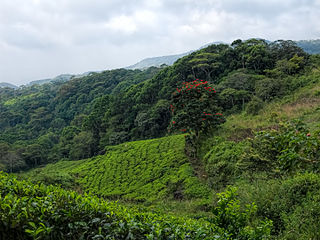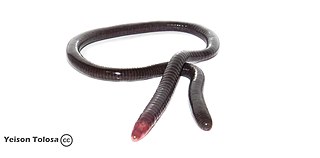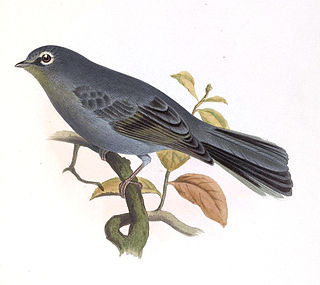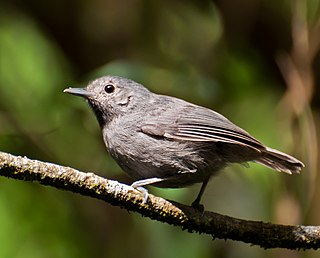
Sinharaja Forest Reserve is a forest reserve and a biodiversity hotspot in Sri Lanka. It is of international significance and has been designated a Biosphere Reserve and World Heritage Site by UNESCO.

The brown mesite is a ground-dwelling bird endemic to Madagascar. It is one of three species in the mesite family or the Mesitornithidae, and though classified as vulnerable by the International Union for Conservation of Nature (IUCN), it is the most widespread of the three.
Microcaecilia albiceps is a species of caecilian in the family Siphonopidae. It is found in the Amazonian lowlands and slopes of the eastern Andes in Colombia and Ecuador, possibly extending into Loreto in Amazonian Peru.

Microcaecilia is a genus of caecilians in the family Siphonopidae.
Microcaecilia supernumeraria is a species of amphibians in the family Siphonopidae. It is endemic to Brazil. Its natural habitats are subtropical or tropical moist lowland forests, plantations, rural gardens, and heavily degraded former forest.
Microcaecilia taylori is a species of caecilian in the family Siphonopidae. It is known from two widely separated populations, one in southern Suriname and other one in Pará, Brazil, south of the Amazon River. It is not clear whether the gap is real or whether the populations south of the Amazon River represent a distinct species. Microcaecilia taylori was confused with Microcaecilia marvaleewakeae before the latter was described in 2013.

Microcaecilia nicefori is a species of caecilian in the family Siphonopidae. It is endemic to Colombia. Its natural habitats are subtropical or tropical moist lowland forests, arable land, pastureland, plantations, rural gardens, heavily degraded former forest, and irrigated land.
Microcaecilia pricei is a species of caecilian in the family Siphonopidae. It is endemic to Colombia. Its natural habitats are subtropical or tropical moist lowland forests, subtropical or tropical moist montane forests, pastureland, plantations, rural gardens, heavily degraded former forest, and irrigated land.
Eleutherodactylus gossei is a species of frog in the family Eleutherodactylidae. It is endemic to Jamaica where it is widespread. An introduced population existed in Bermuda but appears to have been extirpated. The specific name gossei honors Philip Henry Gosse, an English naturalist, missionary, and science writer. Its common names are Jamaican forest frog and Spaldings robber frog, the latter apparently after Spaldings, its type locality.
Eleutherodactylus sciagraphus is a species of frog in the family Eleutherodactylidae. It is endemic to Haiti and only known from near its type locality at an elevation of 1,060–1,080 m (3,480–3,540 ft) asl in the Massif de la Hotte. Its specific name refers to its heavily barred hindlimbs. Its common name is Sud robber frog.

The dwarf coqui or elfin coqui is a species of frog endemic to Puerto Rico. It is placed in the subgenus Eleutherodactylus.
Oreophryne unicolor is a species of frog in the family Microhylidae. It is endemic to West Papua, Indonesia, and known from the Wondiwoi Mountains at the base of the Wandammen Peninsula, Papua province. Frogs with similar call have been observed in the Fakfak Mountains, but it remains to be ascertained that these represent the same species. The specific name unicolor refers to the uniformly coloured dorsal side of the body.
Ptychadena chrysogaster is a species of frog in the family Ptychadenidae. It is found in eastern Democratic Republic of the Congo (Kivu), Burundi, Rwanda, and southwestern Uganda, with an isolated record from Serengeti, Tanzania. Common names yellow-bellied ridged frog, golden-bellied rocket frog, and Rwanda grassland frog have been coined for it.

The uniform finch is a species of bird in the family Thraupidae.

The slate-colored solitaire is a species of bird in the family Turdidae. It is found in Belize, El Salvador, Guatemala, Honduras, Mexico, and Nicaragua. Its natural habitat is subtropical or tropical moist montane forests.

The unicolored antwren is a species of bird in the family Thamnophilidae. It is endemic to southeastern Brazil.
Microcaecilia iwokramae is a species of caecilian in the family Siphonopidae. It is endemic to Guyana and only known from its type locality in the Iwokrama Forest. It was first described as Caecilita iwokramae in the monotypic genus Caecilita, before being recognised as belonging to Microcaecilia.
Amblyodipsas teitana, also known as the Taita Hills purple-glossed snake or Teitana purple-glossed snake, is a species of venomous rear-fanged snake in the family Lamprophiidae. It is endemic to the Taita Hills in Kenya, and only known from the holotope, a 43 cm (16.9 in) female, first identified as Calamelaps unicolor by Arthur Loveridge in 1936.

The Siphonopidae are the family of common caecilians. They are found in Central and South America. Like other caecilians, they superficially resemble worms or snakes.

Tsitongambarika is a lowland forest in southern Madagascar. The area supports many rare species of amphibians, birds, lemurs and reptiles; many of which are endemic. In 2001, the site was designated as an Important Bird Area by BirdLife International and in 2015, an area of 600 km² received environmental protection by the government. The reserve is the recipient of monies raised by the 2016 Rutland Birdfair.










